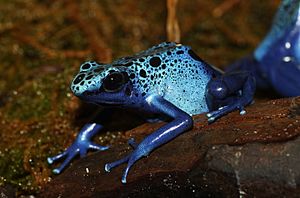Dendrobatoidea facts for kids
Quick facts for kids Dendrobatoidea |
|
|---|---|
 |
|
| Dendrobates azureus | |
| Scientific classification | |
| Kingdom: | |
| Phylum: | |
| Class: | |
| Order: | |
| Suborder: | |
| Superfamily: |
Dendrobatoidea
Cope, 1865
|
| Families | |
|
See text. |
|
Dendrobatoidea is a special group of frogs. In science, a "superfamily" is like a big family that includes smaller families of animals that are closely related. This group includes some of the most colorful and well-known frogs in the world, especially the famous poison dart frogs.
These amazing amphibians live in the warm, wet rainforests of Central America and South America. They are known for their bright colors, which often warn predators that they are poisonous.
Contents
What are Dendrobatoidea?
The Dendrobatoidea superfamily is made up of two main families of frogs. Scientists use a system called taxonomy to organize and name all living things. This helps us understand how different animals are related to each other.
The two families in the Dendrobatoidea superfamily are:
- Aromobatidae (named by Grant et al. in 2006)
- Dendrobatidae (named by Cope in 1865)
Both families include frogs that can have toxins (poisons) in their skin. However, the Dendrobatidae family is especially famous for its very potent (strong) poisons.
Poison Dart Frogs: A Closer Look
The Dendrobatidae family is often called "poison dart frogs." These frogs are incredibly beautiful, with skin that comes in bright colors like blue, yellow, red, and orange. These vibrant colors are a warning sign to other animals, telling them, "Don't eat me! I'm poisonous!" This is called aposematism.
The poison in their skin is very strong. Some indigenous (native) people in the rainforests used these toxins on the tips of their hunting darts, which is how these frogs got their name. The frogs don't make the poison themselves. Instead, they get it from the tiny insects and other small creatures they eat, like ants and mites. These insects likely get the toxins from the plants they consume. When the frogs eat these insects, the toxins build up in their skin.
If a poison dart frog is raised in captivity and fed a diet without these specific insects, it will not develop the toxins in its skin. This shows how important their natural diet is to their defense.
Where Do They Live?
Dendrobatoidea frogs are found only in the tropical rainforests of Central and South America. They prefer humid (moist) environments near streams and rivers, where they can find plenty of food and places to lay their eggs. Many species live on the forest floor, hidden among leaves and plants.
Conservation
Like many rainforest animals, Dendrobatoidea frogs face threats to their survival. The biggest threat is the loss of their habitat due to deforestation (when forests are cut down for farming or logging). Pollution and climate change also affect their delicate ecosystems.
Many organizations are working to protect these unique frogs and their rainforest homes. By learning about these amazing creatures, we can help raise awareness and support efforts to keep them safe for future generations.
See also
 In Spanish: Dendrobatoidea para niños
In Spanish: Dendrobatoidea para niños

